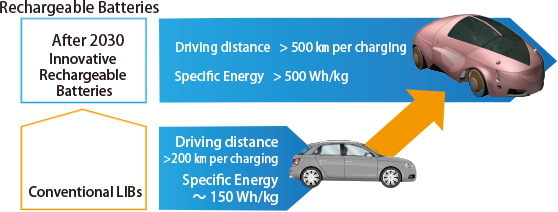Overview and Outlook
Of the Sustainable Development Goals (SDGs), the automobile industry is particularly focused on the goals of “Affordable and Clean Energy,” “Industry, Innovation, and Infrastructure,” and “Climate Action.” Electrification of automobiles is expected to enhance energy efficiency and to suppress greenhouse gas emissions. Since the invention of the “voltaic pile” by Volta in 1800, four types of rechargeable batteries have been widely commercialized. Of these, Li-ion batteries (LIBs) have the highest specific energy and now power many vehicles. However, the further expansion of electric-powered vehicles requires the development of higher-performing batteries that will enable the range per charge to equal that of vehicles powered by internal combustion engines. The Research and Development Initiative for Scientific Innovation of New Generation Batteries (RISING) project started in 2009 under the slogan “Begin with Basics.” The project has developed advanced analytical technologies for operando observation of battery reactions in high time and space resolution, and these technologies have been applied to develop new generation batteries. Following the success of the RISING project, the RISING2 project commenced in 2016 with the aim of developing new, innovative batteries. The RISING2 project aims to further enhance the level of analytical technologies and to develop new, innovative batteries that will be installed in vehicles after 2030.
The RISING2 project is focused on the development of four different types of batteries: the “fluoride shuttle battery” and the “zinc–air battery,” whose reactions are based on anion (F– and OH–) transfer, and the “conversion-type battery” and “sulfide battery,” whose reactions are based on cation (Li+) transfer. The aim of this project is to develop new, innovative batteries with a specific energy of 500 Wh/kg or more for utilization in future electric vehicles. Based on an understanding of the detailed reaction pathway of each battery system, with the assistance of advanced analytical technologies and an understanding of the performance required for the materials in each battery system, we are challenging the development of new batteries by addressing a wide range of issues from material design to battery system design.
The four types of batteries are in different stages of development, while we are targeting their practical installation in vehicles. These different types of new batteries will be introduced to the EV market in stages.

